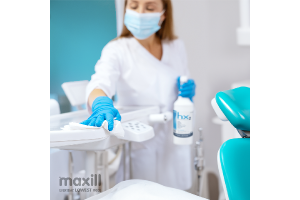What Is HVE in Dentistry?

In dentistry, managing infection control is essential to ensure patient safety and prevent the spread of disease. One of the most important tools in preventing the spread of infection in dental procedures is the high-volume evacuator (HVE). In this article, we explore how HVEs work, the benefits, and how they are used to control the spread of infection and assist with dental procedures.
What is HVE?
HVE is a dental tool that features a large, flexible tube connected to a powerful suction system within a dental office, used to remove fluids and debris from a patient's mouth during dental procedures. The HVE is used in conjunction with other dental instruments, such as handpieces and rotary instruments, to provide a clean and safe working environment for the dental professional.
How HVEs Control the Spread of Infection
HVEs play a critical role in infection control by promptly removing aerosols and minimizing the risk of cross-contamination. This swift removal of potentially contaminated particles significantly reduces the transmission of infections among patients and staff, elevating overall safety standards.
Benefits of Using HVEs in Dentistry
High-volume evacuators (HVEs) are pivotal tools in dental settings due to their numerous benefits in infection control, procedure efficiency, and patient comfort. Let's explore deeper into each benefit and understand their role in dental clinics.
Reducing Aerosols: Aerosols are tiny particles that can contain harmful microorganisms. HVEs significantly decrease aerosols by quickly suctioning fluids and debris generated during dental procedures. This reduces the risk of infections being transmitted between patients and staff, creating a safer environment.
Improved Visibility: By swiftly removing fluids and debris, HVEs enhance the visibility for dental professionals. A clearer view of the treatment area ensures accuracy and precision during procedures, leading to better outcomes.
Enhanced Patient Comfort: HVEs prevent the accumulation of fluids in the patient's mouth, which can improve comfort by minimizing the sensation of pooling fluids. This reduces the chances of gagging, coughing, or choking on water, making the experience more pleasant for the patient.
Reduced Procedure Time: The effectiveness of HVEs in clearing fluids and debris allows for quicker and smoother procedures. As a result, less time is spent on cleaning and preparing the treatment area, leading to shorter overall chair times.
Setup in a Dental Clinic: HVEs consist of a large, flexible tube connected to a powerful suction system. They are typically integrated into the dental chair or unit, making them easily accessible during procedures. Dental professionals maneuver the hose with the attached HVE valve that holds a High-volume adapted tip to use in the patient's mouth as needed to effectively remove fluids and debris.
How HVEs Assist Dental Clinicians
Infection Control: HVEs play a pivotal role in infection control by swiftly eliminating potentially contaminated aerosols, reducing the risk of transmission between patients and staff.
Improved Procedure Efficiency: By maintaining a clean and clear treatment area, HVEs assist dental professionals in performing procedures with greater precision and speed, ultimately enhancing the quality of care.
Patient Comfort: Removing fluids promptly helps in preventing discomfort caused by pooled fluids, making the experience more comfortable for patients and facilitating efficient procedures.
Conclusion
High-volume evacuators serve as requirements in dental clinics, fostering safety, improving visibility, enhancing patient comfort, and optimizing procedural efficiency by adeptly managing fluids and debris.
Their critical role in infection control is undeniable, encouraging a hygienic and secure environment for both patients and dental professionals. Having HVEs into dental practices not only ensures meticulous care but also underscores the commitment to maintaining high standards of safety and patient well-being.
Sources:
- https://weintraubcenter.dentistry.ucla.edu/high-volume-evacuation-tips#:~:text=HVE%20tips%20offer%20additional%20protection,reducing%20the%20risk%20of%20contamination.
- https://pocketdentistry.com/10-moisture-control/
- https://www.burkhartdental.com/high-volume-evacuators/
- https://weintraubcenter.dentistry.ucla.edu/high-volume-evacuation-tips#:~:text=A%20high%2Dvolume%20evacuator%20
- https://www.nu-bird.com/high-volume-evacuation-in-dental-hygiene
- https://www.youtube.com/watch?v=tE9CQtLpuBA
- https://www.youtube.com/watch?v=n92FU_iCzCs
- http://medcraveonline.com/JDHODT/JDHODT-09-00371.pdf





